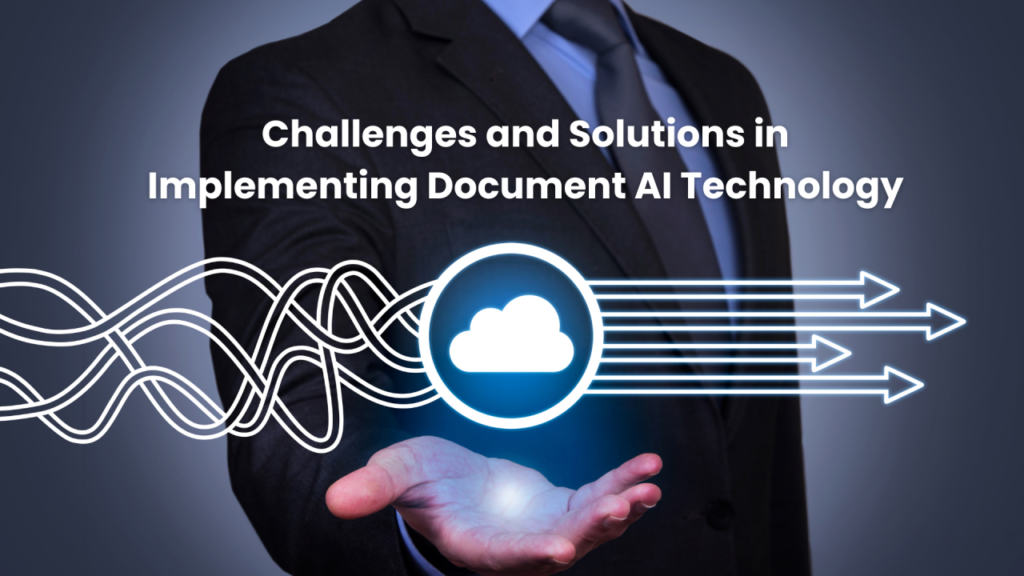Introduction
As organizations increasingly adopt DocAI technology to streamline their operations, the journey toward implementation is often fraught with challenges. While the potential benefits of enhanced efficiency, accuracy, and decision-making capabilities are significant, understanding the common obstacles and their solutions is crucial for successful integration. In this blog, innovon.ai explore the challenges organizations face when implementing DocAI technology and present practical solutions to overcome them.
1. Data Quality and Preparation
Challenge
One of the primary challenges in implementing DocAI is ensuring the quality of the data being processed. DocAI relies on machine learning algorithms that require large amounts of high-quality data for training. If the data is incomplete, inaccurate, or poorly formatted, it can lead to unreliable outcomes, undermining the effectiveness of the AI system.
Solution
To address this challenge, organizations should prioritize data cleaning and preparation before deployment. This involves:
- Conducting Data Audits: Regularly review data sources for accuracy and completeness.
- Standardizing Data Formats: Implement uniform data formats to ensure consistency across documents.
- Utilizing Data Annotation Tools: Use annotation tools to label data appropriately, enhancing the training process for machine learning models.
2. Integration with Existing Systems
Challenge
Many organizations operate with legacy systems that may not easily integrate with new DocAI solutions. This lack of compatibility can lead to data silos, reduced efficiency, and increased operational costs.
Solution
To facilitate seamless integration, organizations can take the following steps:
- Choosing Compatible Solutions: Opt for DocAI solutions that offer robust APIs and integration capabilities with existing software.
- Creating Middleware Solutions: Develop custom middleware to bridge the gap between legacy systems and new DocAI technologies.
- Investing in Change Management: Engage IT teams and stakeholders early in the process to ensure alignment and smooth transitions between systems.
3. Resistance to Change
Challenge
Employees may resist adopting DocAI technology due to fear of job displacement or discomfort with new processes. This resistance can hinder the successful implementation of AI solutions.
Solution
To mitigate resistance, organizations should:
- Promote a Culture of Innovation: Encourage employees to embrace change by highlighting the benefits of DocAI, such as reduced workloads and enhanced job satisfaction.
- Provide Training and Support: Offer comprehensive training programs to help employees adapt to new tools and workflows.
- Involve Employees in the Process: Involve staff in the selection and implementation process to foster a sense of ownership and commitment.
4. Security and Compliance Concerns
Challenge
With the increasing focus on data privacy and security, organizations must address concerns related to the handling of sensitive information. Non-compliance with regulations such as GDPR or HIPAA can lead to severe penalties.
Solution
To enhance security and compliance, organizations should:
- Implement Robust Security Protocols: Employ encryption, access controls, and secure data storage solutions to protect sensitive information.
- Regularly Review Compliance Policies: Stay updated on regulatory requirements and ensure that DocAI processes comply with industry standards.
- Conduct Risk Assessments: Perform regular assessments to identify vulnerabilities in document processing workflows and address them proactively.
5. Scalability Issues
Challenge
As businesses grow, their document processing needs may evolve. A DocAI solution that works well for a small-scale operation may struggle to handle larger volumes of documents or more complex tasks.
Solution
To ensure scalability, organizations can:
- Select Flexible Solutions: Choose DocAI technologies that can scale easily to accommodate increasing volumes of data and more complex processing requirements.
- Monitor Performance Metrics: Regularly track performance indicators to identify bottlenecks and areas for improvement.
- Plan for Future Needs: Anticipate future growth and invest in scalable infrastructure from the outset.
6. Lack of Expertise
Challenge
The implementation of DocAI technology requires specialized skills that many organizations may lack. This can lead to suboptimal use of the technology and missed opportunities for optimization.
Solution
To address the skills gap, organizations can:
- Invest in Training Programs: Offer internal training sessions or partner with external providers to upskill employees in AI and document processing technologies.
- Hire Specialized Talent: Consider bringing in AI specialists or consultants who can guide the implementation process and provide ongoing support.
- Foster Collaboration: Encourage collaboration between IT and business units to share knowledge and best practices for using DocAI.
7. Ensuring Accuracy and Reliability
Challenge
While DocAI can significantly enhance efficiency, there are still concerns about the accuracy and reliability of AI-generated outputs. Inaccurate data extraction or misinterpretation of documents can have serious consequences, especially in critical sectors like healthcare and finance.
Solution
To enhance accuracy, organizations should:
- Implement Human Oversight: Introduce a review process where human experts validate AI-generated outputs, particularly during the initial stages of deployment.
- Continuously Train Models: Regularly update and retrain AI models with new data to improve their accuracy and adapt to changing document types and formats.
- Utilize Feedback Loops: Establish mechanisms for users to provide feedback on AI performance, which can inform future improvements.
8. Budget Constraints
Challenge
The cost of implementing DocAI technology can be a significant barrier, particularly for smaller organizations or those with limited budgets. Expenses can include software licenses, infrastructure upgrades, and training costs.
Solution
To manage costs effectively, organizations can:
- Conduct Cost-Benefit Analyses: Evaluate the potential return on investment (ROI) of DocAI solutions to make informed financial decisions.
- Explore Scalable Solutions: Consider cloud-based DocAI platforms that offer flexible pricing models based on usage, allowing organizations to pay only for what they need.
- Seek Grants and Funding: Investigate grants, funding opportunities, or partnerships that can help subsidize the costs of implementing new technologies.
9. Keeping Pace with Rapid Changes
Challenge
The field of AI is rapidly evolving, making it challenging for organizations to stay current with the latest technologies and best practices. This can result in outdated implementations that fail to leverage the full potential of DocAI.
Solution
To stay ahead of the curve, organizations can:
- Invest in Continuous Learning: Encourage ongoing education and professional development for employees to keep up with industry trends and advancements.
- Engage with the AI Community: Participate in industry forums, conferences, and workshops to learn from experts and share experiences with peers.
- Adopt Agile Methodologies: Implement agile project management practices that allow for quick iterations and adjustments to DocAI strategies based on new insights and technologies.
Conclusion
Implementing DocAI technology presents a range of challenges, but these obstacles are not insurmountable. By recognizing these challenges and adopting proactive solutions, organizations can successfully integrate DocAI into their operations, unlocking the potential for enhanced efficiency, accuracy, and insights. The journey may require investment, planning, and cultural shifts, but the rewards are well worth the effort. As the digital landscape continues to evolve, those who embrace Document AI will position themselves for success in an increasingly competitive market.





